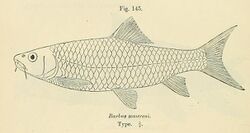Biology:Labeobarbus somereni
| Labeobarbus somereni | |
|---|---|

| |

| |
| Scientific classification | |
| Domain: | Eukaryota |
| Kingdom: | Animalia |
| Phylum: | Chordata |
| Class: | Actinopterygii |
| Order: | Cypriniformes |
| Family: | Cyprinidae |
| Subfamily: | Cyprininae |
| Genus: | Labeobarbus |
| Species: | L. somereni
|
| Binomial name | |
| Labeobarbus somereni (Boulenger, 1911)
| |
| Synonyms[3] | |
| |
Labeobarbus somereni, or Someren's barb,[4] is a species of ray-finned fish in the family Cyprinidae. It is found in Burundi, Rwanda, Tanzania, and Uganda. Its natural habitat is rivers. It is not considered a threatened species by the IUCN. Local names for the fish in Rwanda include ikinanga, inkwenwe (Middle Akagera), ifurwe (Satinsyi) and urwozi (Nyabarongo).[5]
It was first described by George Albert Boulenger in 1911. Its holotype was caught by Victor Van Someren and its type locality was described as: "the Sebwe River, a snow-water stream on Mount Ruwenzori, in Uganda, at an altitude of 6,000 feet (1,800 m)."[2] The holotype is at the Natural History Museum, London.[6][7] It was initially placed in the genus Barbus but is now classified as a Labeobarbus species.[8][9] It might be able to hybridize with L. ruwenzorii,[10] and it might be a senior synonym of L. mirabilis.[11][9]
In Tanzania, it has been recorded at high altitudes in the headwaters of rivers including the Victoria River, Tanganyika River, Kagera River, and the Malagarasi River.[12] In Rwanda it has been recorded in the Ruzizi basin and the Upper and Middle Akagera River, on either side of the Rusumo Falls.[4] The International Union for Conservation of Nature designate L. somereni as a least-concern species, saying it is "relatively widespread", although it's possible some subpopulations might be at risk from various local threats such as increased farming.[1] It is omnivorous, although primarily herbivorous; it mostly eats aquatic plants and filamentous algae.[13]
References
- ↑ 1.0 1.1 FishBase team RMCA; Geelhand, D. (2018). "Labeobarbus somereni". IUCN Red List of Threatened Species 2018: e.T60355A136079431. doi:10.2305/IUCN.UK.2016-3.RLTS.T60355A136079431.en. https://www.iucnredlist.org/species/60355/136079431. Retrieved 16 November 2021.
- ↑ 2.0 2.1 Boulenger, G.A. (1911). "Descriptions of Two new African Barbels". Journal of Natural History. Ser. 8 8 (45): 369. doi:10.1080/00222931108693039. https://www.biodiversitylibrary.org/page/22099032.
- ↑ Lévêque, C.; Daget, J. (1984). "Cyprinidae". in Daget, J.; Gosse, J.-P.; Thys van den Audenaerde, D. F. E.. Check-list of the Freshwater Fishes of Africa. 1. Paris: ORSTOM. p. 287. http://horizon.documentation.ird.fr/exl-doc/pleins_textes/divers13-06/15357.pdf.
- ↑ 4.0 4.1 De Vos, Luc; Snoeks, Jos; van den Audenaerde, Dirk Thys (2001). "An Annotated Checklist of the Fishes of Rwanda (East Central Africa), With Historical Data on Introductions of Commercially Important Species". Journal of East African Natural History 90 (1): 62. doi:10.2982/0012-8317(2001)90[41:AACOTF2.0.CO;2].
- ↑ De Vos, L.; Thys van den Auudenaerde, D. (1990). "Description de Barbus claudinae sp. n. (Cyprinidae) avec synopsis des grandes espèces de Barbus du Rwanda". Cybium 14 (1): 13–15. http://sfi-cybium.fr/node/2126.
- ↑ Boulenger, George Albert (1916). "Barbus somereni". Catalogue of the Fresh-Water Fishes of Africa in the British Museum. London: Taylor and Francis. pp. 229–230. https://www.biodiversitylibrary.org/page/39310850.
- ↑ "1911.7.26.1". London: Natural History Museum. 2017. http://data.nhm.ac.uk/object/b617dbfc-9d4c-4fd5-b899-b7cd35b4bd4a.
- ↑ Skelton, Paul; Bills, Roger (2008). "An Introduction to African Yellowfish and to this Report". in Impson, N. D.; Bills, I. R.; Wolhuter, L.. Technical Report on the State of Yellowfishes in South Africa 2007. WRC Report. KV 212/08. Pretoria: Water Research Commission. p. 12. ISBN 978-1-77005-719-7. http://www.wrc.org.za/Knowledge%20Hub%20Documents/Research%20Reports/KV212-web-conservation.pdf. Retrieved 14 September 2017.
- ↑ 9.0 9.1 Vreven, Emmanuel J. W. M. N.; Musschoot, Tobias; Snoeks, Jos; Schliewen, Ulrich K. (2016). "The African hexaploid Torini (Cypriniformes: Cyprinidae): review of a tumultuous history". Zoological Journal of the Linnean Society 177 (2): 299. doi:10.1111/zoj.12366.
- ↑ Banister, Keith Edward (1972). "On the Cyprinid Fish Barbus alluaudi Pellegrin: A Possible Intergenetic Hybrid from Africa. Studies on African Cyprinidae Part I". Bulletin of the British Museum (Natural History). Zoology 24 (5): 266–271. https://www.biodiversitylibrary.org/page/26497770; Pl. 1, Fig. a.
- ↑ Banister, K. E. (1973). "A revision of the large Barbus (Pisces, Cyprinidae) of east and central Africa. Studies on African Cyprinidae. Part II". Bulletin of the British Museum (Natural History), Zoology 26 (1): 111–115. https://www.biodiversitylibrary.org/page/2293720.
- ↑ Eccles, David H. (1992). Field Guide to the Freshwater Fishes of Tanzania. Field Guide to the Freshwater Fishes of Tanzania. Rome: Food and Agriculture Organization of the United Nations. pp. 46, 119. http://www.fao.org/docrep/010/t0605e/t0605e00.HTM.
- ↑ Matthes, H. (1963). "A Comparative Study of the Feeding Mechanisms of some African Cyprinidae (Pisces, Cypriniformes)". Bijdragen tot de Dierkunde 33 (1): 19–23. doi:10.1163/26660644-03301001. http://www.repository.naturalis.nl/record/504603.
External links
- Froese, Rainer and Pauly, Daniel, eds. (2017). "Labeobarbus somereni" in FishBase. September 2017 version.
Wikidata ☰ Q1944571 entry
 |


